Me: “So, ladies and gentlemen, what is an alternate mode of transportation?”
Student: “Bicycle!”
This is the typical response I receive when prompting students about alternate forms of transportation. It is great that students recognize the bicycle as an alternate form of transportation, but this wonderful two- wheeled device deserves a much more in depth explanation than the brief mention it receives during my Environmental Awareness class!
 Let’s roll back in time!
Let’s roll back in time!
To begin let’s take a look back in time to the 1800’s where the primordial bicycle began to take shape. No single person has the credit of actually inventing the bicycle; rather it has evolved and changed with many innovations along the way. The first bike-like object was invented by German inventor Karl Drais in 1817; it had many names including: Velocipede, Laufmashine, and Dandy Horse. It was a simple machine that had two wheels and was propelled by pushing off of the ground in a scissor like motion of the legs. It was made entirely out of wood, talk about a smooth ride!
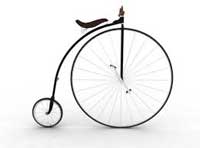 As the 1800’s progressed, the ancestor of the modern bicycle eventually inherited pedals, chains, brakes, and the utilization of other materials like steel to make the frame component. Some innovations proved obsolete and/or particularly dangerous such as the Penny Farthing which had one very large front wheel. It was quite the precarious machine and mounting was tricky; if you fell… well let’s just say it was a long way down! 1
As the 1800’s progressed, the ancestor of the modern bicycle eventually inherited pedals, chains, brakes, and the utilization of other materials like steel to make the frame component. Some innovations proved obsolete and/or particularly dangerous such as the Penny Farthing which had one very large front wheel. It was quite the precarious machine and mounting was tricky; if you fell… well let’s just say it was a long way down! 1
Later, in the 19th century, not only was the bicycle reaching a likeness resembling what we see today, but it also helped to implement social change.
Women now had a newfound liberty, and gentlemen could easily and effectively commute to jobs. Also, a good portion of the technology that was developed for the bicycle eventually was used for early automobiles, so you could think of the bicycle as the distant cousin of cars! 2
So what does the bicycle have to do with California?
I’m glad you asked, in fact, a lot of monumental achievements of the bicycle have been made in or started in California. The first is the beginning of the journey started by Thomas Stevens, who was the first man to ride a bike across the continental U.S. His journey began in San Francisco with a pair of socks, a fresh shirt, a rain jacket, and his bike of course. He began on the morning of April 22, 1884 and ended on August 4th of the same year. After a brief rest in Boston, Thomas continued and eventually rode his bike around the world!
Also, the first bike messenger business began in Fresno, California when the railroad strike meant no mail for the Bay area. An enterprising bicycle shop owner set up a mail relay to supply San Francisco and the surrounding area with mail. 3
Lastly, fast forward to the 1970’s to Marin County, California on Pine Mountain where the archetype of the mountain bike was refined by the likes of Gary Fisher on the downhill route Repack. It was named Repack because the bearings in the wheels of the bikes would heat up so much that the grease would have to be repacked at the bottom of the route. 4
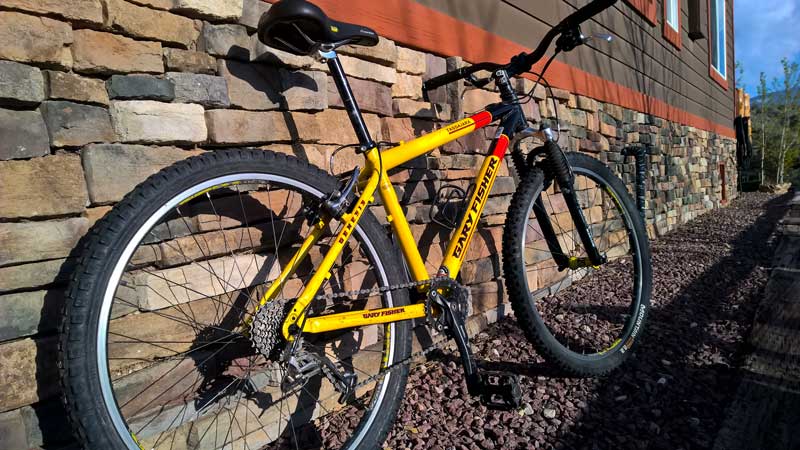 Okay… can we get to what really matters?
Okay… can we get to what really matters?
Well of course we can, it’s just that, we have to understand where we’ve been to know where we are going! In terms of efficiency the bicycle in all of its forms is the most efficient means of human transportation. 5
Wait, what? That is correct. The bike is more efficient than any car, any airplane, it’s even more efficient than walking.
It may be easy to hop in my car and push the gas pedal, but getting to this point takes a lot. You have to think about the gasoline that is a byproduct of the refinement of crude oil. 6 Then you have to think about all of the millions of years it took photosynthesizing marine organisms to take CO2 out of the atmosphere, store it, die, drift to the bottom of the ocean, be covered in sediment, then subjected to immense pressure, to eventually become crude oil. 7
 And what about Cheetahs?
And what about Cheetahs?
Now think about how much your car weighs and how fast you are going. A cheetah can hit 60 miles per hour but maintain this speed for only 30 seconds and in extreme circumstances a minute. 8 After such an intense energy expenditure they have to rest for half an hour. And a cheetah is just carrying their own body weight; no more. This same speed, 60 miles an hour is pretty easy to go in an automobile for hours at a time, even with an average US car weight of 4000 pounds. 9 Enter the bicycle, weighing in at around 25 pounds.
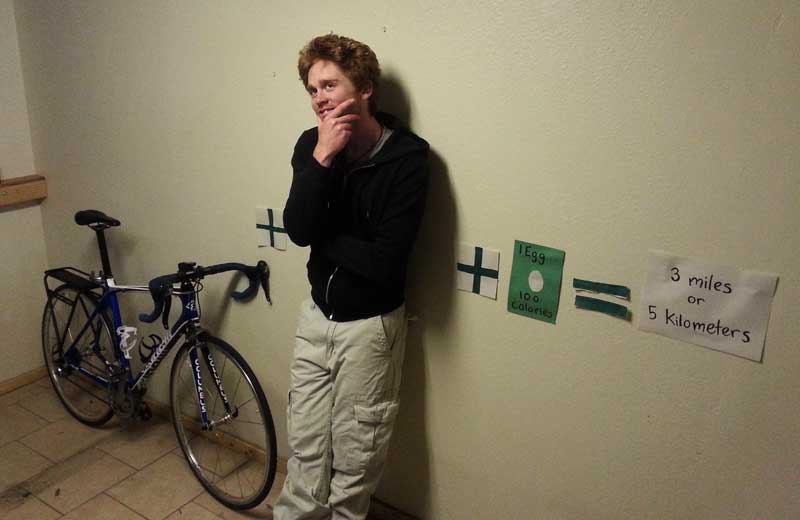 Calculate it Out Mikey.
Calculate it Out Mikey.
I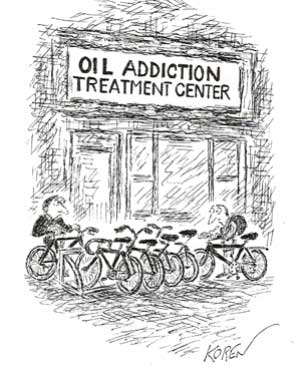 t takes about 100 calories or a large egg for a 140 pound person riding a bicycle at 10 mph to travel 3 miles. Keep in mind that riding a bicycle at 10 mph is considered a light effort. For comparison, that same person will need 300 calories or about three eggs to travel the same distance walking. It would take a car that has a fuel economy of 12.5 miles per gallon 93 eggs to travel the same distance; that means the bicycle is 93 times more efficient! Let’s not be hasty, let’s compare something that has a chance of measuring up. Take for example the Toyota Prius, a fully loaded Prius with four adults still burns 25 times the energy that 1 person on a bike takes to travel 3 miles. 10
t takes about 100 calories or a large egg for a 140 pound person riding a bicycle at 10 mph to travel 3 miles. Keep in mind that riding a bicycle at 10 mph is considered a light effort. For comparison, that same person will need 300 calories or about three eggs to travel the same distance walking. It would take a car that has a fuel economy of 12.5 miles per gallon 93 eggs to travel the same distance; that means the bicycle is 93 times more efficient! Let’s not be hasty, let’s compare something that has a chance of measuring up. Take for example the Toyota Prius, a fully loaded Prius with four adults still burns 25 times the energy that 1 person on a bike takes to travel 3 miles. 10
Keep in mind that any vehicle you drive spits out exhaust; you multiply that by the 30 million autos that are in California and you have the ingredients for that hazy smog that makes looking in the distance a difficult task. 11 Also, factor in that a bicycle is way easier to work on yourself, and it doesn’t cost an astronomical amount of money to maintain, unlike an automobile.
Isn’t there this thing about fitness and getting in shape?
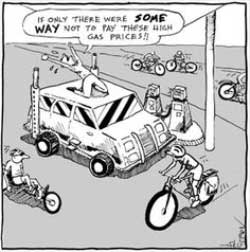 Well, of course, silly. I just told you how many calories are burned for a 140 lb person that travels three miles at 10 mph. If you want to burn more calories, simply go faster, add some hills, wind resistance, hot and cold weather, and you realize that the bicycle is literally a fat burning machine!
Well, of course, silly. I just told you how many calories are burned for a 140 lb person that travels three miles at 10 mph. If you want to burn more calories, simply go faster, add some hills, wind resistance, hot and cold weather, and you realize that the bicycle is literally a fat burning machine!
What’s more, instead of your boring commute waiting in traffic to go five miles; you could hop on your bike, ride to work, and feel alert and ready to begin the work day. I guess by now you’ve realized that the bicycle doubles figuratively as a piggy bank, and guess what, no exhaust! Don’t forget that it takes fuel to ride a bicycle, and this comes in the form of food. Riding a bicycle makes your food choices better because your body is the engine, and the better the fuel you put in, the better results you will get out; thus, reinforcing better and conscientious eating habits.

Are you sure, I mean a lot of this sounds too good to be true?
Skeptical? I understand. It’s hard to believe that just a curious combination of basic shapes such as: triangles and circles; century old technology; gears, chains, levers; and materials including: steel, aluminum, titanium, and carbon fiber, could unify and make a contraption that is as simple as it is versatile and efficient as it is liberating. That is the beauty of the machine we know as the bicycle.
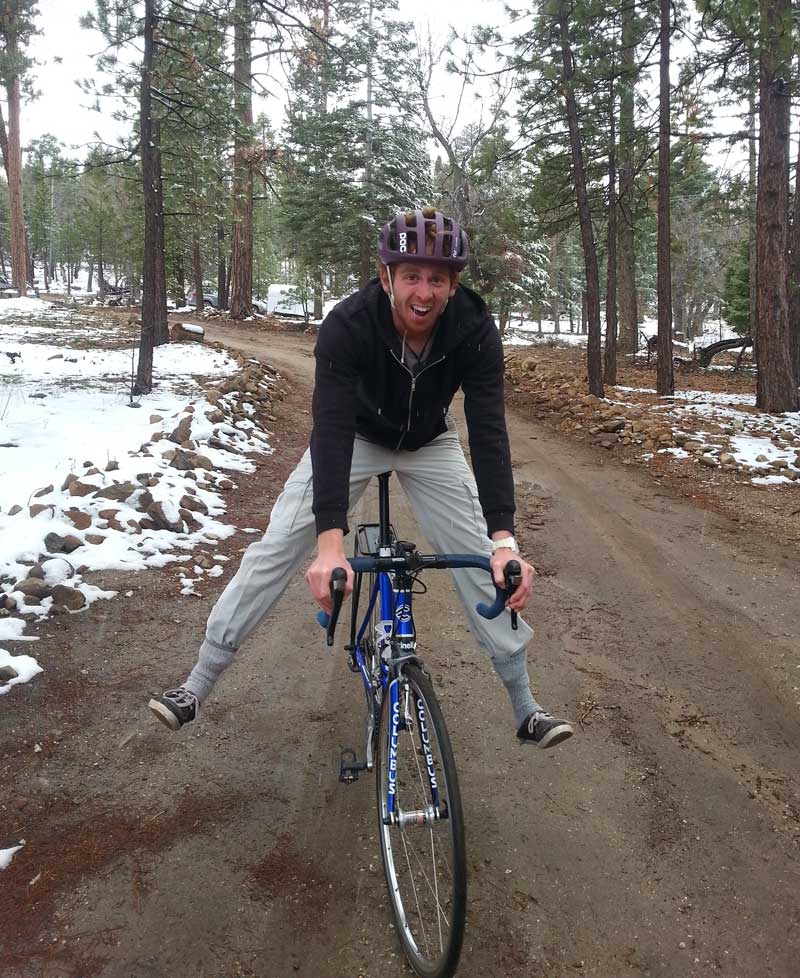
This, however, is Mikey.
At High Trails Outdoor Science School, we literally force our instructors to write about elementary outdoor education, teaching outside, learning outside, our dirty classroom (the forest…gosh), environmental science, outdoor science, and all other tree hugging student and kid loving things that keep us engaged, passionate, driven, loving our job, digging our life, and spreading the word to anyone whose attention we can hold for long enough to actually make it through reading this entire sentence. Whew…. www.dirtyclassroom.com
- http://www.ibike.org/library/history-timeline.htm ↩
- http://amhistory.si.edu/onthemove/themes/story_69_3.html ↩
- http://www.ibike.org/library/history-timeline.htm ↩
- http://mmbhof.org/mtn-bike-hall-of-fame/history/repack-history/ ↩
- http://www.exploratorium.edu/cycling/humanpower1.html ↩
- http://www.madehow.com/Volume-2/Gasoline.html ↩
- http://www.adventuresinenergy.org/What-are-Oil-and-Natural-Gas/How-Are-Oil-Natural-Gas- Formed.html ↩
- http://bigcatrescue.org/cheetah-facts/ ↩
- http://business.time.com/2012/08/17/losing-weight-is-a-hot-trend-in-the-auto-industry/ ↩
- http://www.ibike.org/environment/efficiency.htm ↩
- http://www.statista.com/statistics/196024/number-of-registered-automobiles-in-california/ ↩

Comments are closed.